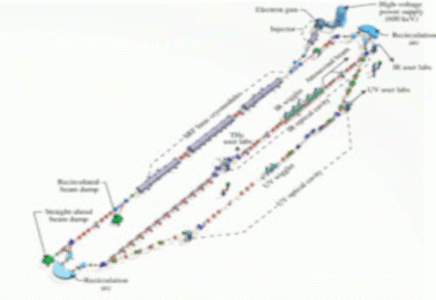SRF-Based Energy-Recovering Linear Accelerators (ERLs)

A 160 MeV, 10 milliampere energy-recovering linear accelerator (ERL) drives JLab's upgraded free-electron laser (FEL). The FEL produces up to 10 kilowatts of light when the electron beam slaloms through the array of magnets in the infrared wiggler, or up to 1 kilowatt when directed through the recently installed ultraviolet wiggler. The electron beam recirculates through the linear accelerator and is decelerated for energy recovery, recycling the beam's energy for accelerating new electrons. The beam itself is dumped. Besides driving the wigglers, the ERL yields terahertz light directly when the beam passes through a bending magnet.
Additional Links
Jefferson Lab has become the acknowledged world leader in the development of an innovative use of electron linear accelerators (linacs) in light sources and, potentially, particle colliders: the energy-recovering linac, or ERL. Jefferson Lab built the first ERL with high average current to drive the first kilowatt-scale free-electron laser.
Unlike the recycling of electrons in a synchrotron or a storage ring, an ERL uses a conceptually simple phasing technique to recycle the electrons' energy. On a path measuring exactly an integer multiple of the linac radiofrequency (RF) wavelength plus a half-wavelength, an ERL’s accelerated beam travels through an experiment and re-enters the linac to yield back its energy, via the RF field, to the beam being accelerated. The decelerated beam is then dumped at low energy.
An obvious advantage of ERLs is economic. Consider, for example, the ERL-driven 4th Generation Light Source (4GLS) facility planned for Daresbury in the U.K., where a prototype ERL is under construction. In May 2003, Physics World reported that without energy recovery, "4GLS would consume roughly the output of a large commercial power station." Energy recovery also simplifies spent-beam disposal. But the overall promise of ERLs is far more than economic, and has been distilled in the paper cited below.
Reference
Lia Merminga, David R. Douglas and Geoffrey A. Krafft, Annual Review of Nuclear and Particle Science 53387 (2003)

